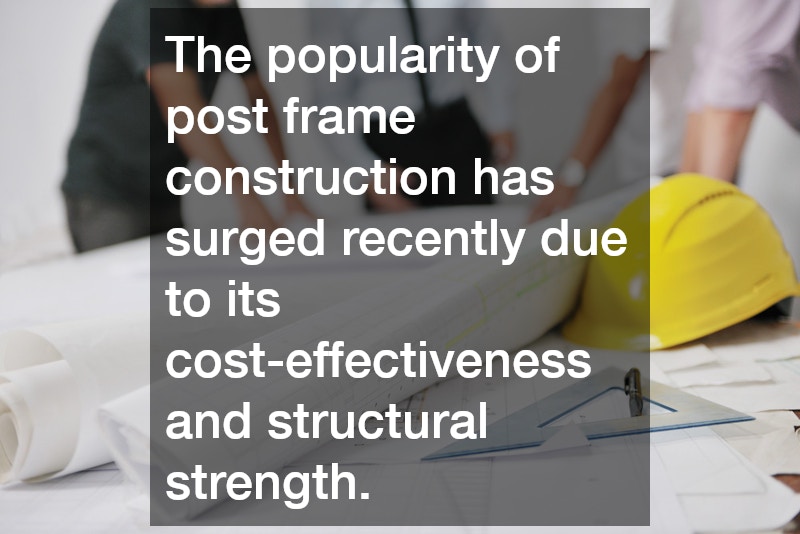Post frame construction is a method of building that employs large, laminated wooden posts or columns. These posts are typically buried into the ground or secured on top of a concrete foundation, providing the primary support for the structure. This construction style offers significant flexibility and speed in erection, making it ideal for commercial applications. The design is adaptable, allowing commercial building companies to tailor the space to specific business requirements. Furthermore, the simplicity of post frame construction allows for a reduction in materials and labor costs, a benefit highly valued by businesses looking to manage expenses.
The popularity of post frame construction has surged recently due to its cost-effectiveness and structural strength. The large wooden posts spaced around 8 feet apart enable rapid construction speeds, translating into quicker project completions. Additionally, this building technique offers superior energy efficiency due to wide-column spacing, which allows for greater insulation options. As commercial building companies seek to support sustainable practices, post frame construction emerges as an attractive option. Moreover, the versatility of this method supports a variety of aesthetic finishes, ensuring that the final structure aligns with a company’s brand image.
Commercial facilities demand both functionality and design flexibility, and post frame construction delivers on these fronts. With the ability to span larger distances without internal support columns, companies benefit from wide-open spaces that can be customized according to operational needs. The adaptability of these structures also means that they can evolve with the business, accommodating expansions or modifications with relative ease. Post frame constructions support a variety of external siding options such as metal, wood, or vinyl, further enhancing their appeal. As businesses grow increasingly conscious of environmental impacts, the minimal waste generated by post frame methods also contributes to their long-term viability.
The Advantages of Post Frame Construction for Commercial Buildings
Several key advantages make post frame construction an appealing choice for commercial facilities. Firstly, the reduced construction times translate into faster returns on investment. Businesses can begin their operations sooner due to the efficient building process, which can be critical in industries where time-to-market is essential. This efficiency is particularly beneficial for commercial building companies aiming to meet strict deadlines. Fast erection times do not sacrifice structural integrity, as these buildings offer resilience in varied climates.
Another significant advantage lies in the cost savings associated with post frame construction. Lower material costs are possible due to the reduced need for elaborate structural components and foundations. Coupled with decreased labor expenses, these savings are substantial, allowing businesses to allocate funds to other areas of operation or marketing. Furthermore, the maintenance costs for post frame structures tend to be lower over time, contributing to long-term affordability. Commercial building companies can capitalize on these savings to offer competitive pricing models to their clients.
Environmental considerations are increasingly influencing construction decisions, and post frame buildings align well with green initiatives. By optimizing material usage and enhancing energy efficiency through improved insulation capabilities, these structures support eco-friendly practices. This alignment is particularly attractive to companies aiming to reduce their carbon footprint. Additionally, post frame constructions can be easily adapted to incorporate renewable energy systems, such as solar panels, further reducing operational costs. For commercial building companies, being able to offer sustainable building solutions can set them apart in a competitive market.
Challenges and Considerations in Post Frame Construction
Despite its many advantages, post frame construction is not without challenges that businesses must consider. One potential issue is the availability of qualified contractors experienced in this specialized construction method. Commercial building companies must ensure that they collaborate with skilled professionals who understand the nuances of post frame design and build. Ensuring expertise and proper training can prevent structural issues and ensure the project’s long-term success. Additionally, local zoning regulations may impose restrictions on post frame construction, necessitating thorough research and compliance.
Weather considerations can also pose a challenge when planning a post frame construction project. While these buildings offer good resistance against various climates, certain materials used in their construction can be vulnerable to extreme conditions. Commercial building companies should evaluate the environment and select materials and protective measures that cater to local climate conditions. Understanding these external influences can mitigate weather-related damages and ensure the structure’s longevity. A comprehensive approach enables companies to deliver durable and reliable structures resilient to environmental stressors.
Another consideration is the level of customization businesses require from their commercial facilities. While post frame construction offers remarkable versatility, companies must clearly articulate their needs during the planning stages. Commercial building companies can greatly assist in transforming these requirements into practical designs that maximize space utilization. Effective communication between clients and builders is crucial to realizing the vision and functionality of the commercial space. Leveraging post frame construction’s adaptability means businesses can achieve spaces that function efficiently and support growth.
As businesses and commercial building companies strategize for the future, post frame construction is poised to grow in relevance and application. The combination of speed, cost-efficiency, and sustainability aligns with contemporary business practices and priorities. With ongoing advancements in construction technology and materials, post frame buildings are becoming even more robust and adaptable. Companies can seize opportunities to innovate within their spaces, fostering environments conducive to success. By understanding both the challenges and benefits, businesses can confidently integrate post frame construction into their strategic development plans.
Embracing post frame construction means investing in a future-oriented approach that champions flexibility and performance. As the commercial real estate landscape evolves, those who adopt this method can enjoy a competitive edge. It reinforces a commitment to sustainable development while meeting the functional and aesthetic needs of modern businesses. Innovation and collaboration between commercial building companies and their clients will be vital in unlocking the full potential of post frame structures. This building method offers a compelling narrative for businesses ready to innovate and adapt their facilities to ever-changing market demands.
In summary, post frame construction embodies a shift towards more efficient, economical, and sustainable building practices. As industries evolve, so too does the need for spaces that are flexible and adaptable to changing operational demands. By leveraging these advantages, commercial building companies can deliver structures that meet current necessities and are prepared for future developments. Investing in post frame construction aligns with a forward-thinking approach, poised to meet the needs of modern businesses dynamically and effectively. Thus, it remains a vital consideration for companies ready to build the future today.

